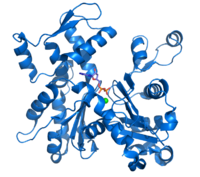
Photo from wikipedia
How mechanical stress applied to the actin network modifies actin turnover has attracted considerable attention. Actomyosin exerts the major force on the actin network, which has been implicated in actin… Click to show full abstract
How mechanical stress applied to the actin network modifies actin turnover has attracted considerable attention. Actomyosin exerts the major force on the actin network, which has been implicated in actin stability regulation. However, direct monitoring of immediate changes in F-actin stability on alteration of actomyosin contraction has not been achieved. Here we reexamine myosin regulation of actin stability by using single-molecule speckle analysis of actin. To avoid possible errors attributable to actin-binding probes, we employed DyLight-labeled actin that distributes identical to F-actin in lamellipodia. We performed time-resolved analysis of the effect of blebbistatin on actin turnover. Blebbistatin enhanced actin disassembly in lamellipodia of fish keratocytes and lamellar of Xenopus XTC cells at an early stage of the inhibition, indicating that actomyosin contraction stabilizes cellular F-actin. In addition, our data show a previously unrecognized relationship between the actin network-driving force and the actin turnover rates in lamellipodia. These findings point to the power of direct viewing of molecular behavior in elucidating force regulation of actin filament turnover.
Journal Title: Molecular Biology of the Cell
Year Published: 2018
Link to full text (if available)
Share on Social Media: Sign Up to like & get
recommendations!